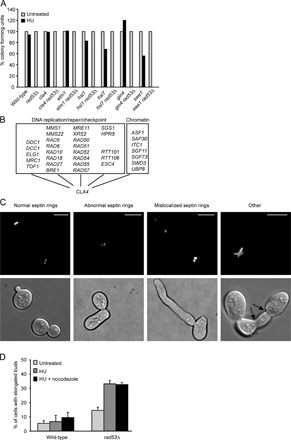
[View Larger Version of this Image]
Figure S4. Septin- and Swe1-regulating mutants are replication checkpoint proficient and recover normally from a HU-induced cell cycle arrest. (A) RDK3615 (wild-type), RDK3750 (rad53Δ sml1), RDK5747 (cla4 sml1), RDK5748 (cla4 rad53Δ sml1), RDK5740 (hsl1 sml1), RDK5739 (hsl1 rad53Δ sml1), RDK5741 (hsl7 sml1), RDK5742 (hsl7 rad53Δ sml1), RDK5744 (elm1 sml1), RDK5743 (elm1 rad53Δ sml1), RDK5745 (gin4 sml1), and RDK5746 (gin4 rad53Δ sml1) cells were either kept in YPD or arrested in 200 mM HU for 4 h. Subsequently, the cells were washed with YPD and plated on YPD plates, and colonies were counted after 2 d at 30°C. For each strain, the number of colonies that appeared on YPD plates was set as 100%. (B) CLA4 genetically interacts with a wide variety of genes known to control DNA replication and repair, the replication checkpoint, and chromatin organization. (C) Examples of septin phenotypes. Septin rings were visualized by immunofluorescence using Cdc11 antibodies, as described in Materials and methods. "Normal septin rings" are crisp rings that localize to the bud neck, whereas "abnormal septin rings" are fuzzy, grainy, or otherwise misshapen rings at the bud neck. Cells with "mislocalized septin rings" have septin rings at a location other than the bud neck, like the bud tip. All residual septin phenotypes are grouped in the class "other," and include, for example, cells that may have no septin ring where there should have been one, as indicated by the arrows. Bar, 5 µm. (D) Nocodazole treatment does not prevent HU-induced elongated bud growth of rad53Δ mutants. Log-phase cultures of RDK3615 (wild-type) and RDK3750 (rad53Δ sml1) cells were either left untreated, treated with 200 mM HU, or with 200 mM HU in combination with 5 µg/ml nocodazole (noco) for 16 h, after which the percentage of cells with elongated buds was determined. Error bars represent the SD.